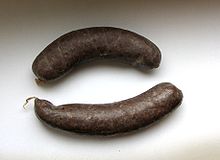Blood sausage
[3] In Europe and the Americas, typical fillers include meat, fat, suet, bread, cornmeal, onion, chestnuts, barley, oatmeal, and buckwheat.Brussels and Sturgeon Bay, Wisconsin, are both home to local grocers who produce blood sausage, due to their large Belgian American populations.German-style blood sausage and Zungenwurst can be found in Fresno and Santa Rosa, where Russian and Armenian delis offer a wide range of Central European foods.Alpine Village in Torrance, California, used to have Blutwurst due to a considerable German-American population in the South Bay area of Los Angeles County.In the Yucatán Peninsula, morcilla is made exclusively from pig's blood and once deep fried it is served with a mix of pickled onions, cilantro and spices.The cooked meat is cut into bite-sized pieces and soaked in a brine made of water, lime juice, cucumbers, hot pepper, and specially prepared seasonings.In Colombia, morcilla can have rice, green peas, cilantro or culantro, and is often eaten as an appetizer called "picada" or with the traditional dishes "Bandeja Paisa" or "Fritanga".In Uruguay and in Argentina, a sweet version, usually called morcilla vasca, including raisins and pine nuts is popular; some vendors even add chocolate, caramelised orange peels, peanuts, and other dried fruits.In Chile, the blood sausage is called "prieta" (a synonym of "negra", black) and tends to have a very thick skin, so is eaten cut open lengthwise.Apart from blood and a little fat, "prietas" may contain a variety of ingredients, such as chopped onion and spices, cabbage, peppers, watercress, rice, meat or even dried fruit or nuts.[18] Matagi hunters of the former Dewa and Mutsu Provinces are known to have made blood sausage using deer intestine and hoshii (糒しい), or dehydrated boiled rice, as filler.A notable native, precolonial blood sausage is pinuneg, made from minced pork meat and innards in a casing of pigs’ large intestine, prepared in the Cordillera Administrative Region.It is also known in Russia as krovyanka (кровянка), or krovyanaya kolbasa (кровяная колбаса, literally "blood sausage") and includes buckwheat as a main filler, instead of oats or oatmeal.In Ukraine it's called krov'yanka (кров'янка) or kryvava kyshka (кривава кишка), and kiszka or kaszanka in Poland; krvavnička in Slovakia and krvavica in Slovenia, krupniok in Silesia.Similarly, in Czech cuisine, jelito is made from second-rate pork, pig's blood and peeled barley; the stuffing served by itself, unformed, is called prejt.In Denmark, blodpølse is made from pigs's blood and suet, rye flour, brown sugar, raisins, salt, cinnamon and cardamom stuffed into natural or artificial intestines.In the past it was occasionally flavoured with pennyroyal, differing from continental European versions in its relatively limited range of ingredients and reliance on oatmeal and barley instead of onions to absorb the blood.Stornoway black pudding produced on the Isle of Lewis, Scotland, is one of the most renowned varieties and has been granted Protected Geographical Indicator of Origin (PGI) status.The exact proportions and ingredients vary, partly according to regional preference, but generally it is made from pig's blood, milk, rye or barley flour, diced lard, either beer or svagdricka, treacle and onion, flavoured with allspice and marjoram.It is a sweet pudding with a thick black filling made with pig's blood, sugar, breadcrumbs, almonds, chocolate, butter and spices contained in a thin pastry crust.The most well-known and widespread is morcilla de Burgos which contains mainly pork blood and fat, rice, onions, and salt, and is produced in two varieties: cylindrical and gut-shaped.There are other similarly famous kinds being made in Asturias (slightly darker and smaller, used for bean and chickpea stews) and León (without rice, grilled & spread on toasted bread).There are many derivative foods made from morcilla, such as omelettes, stuffed red pepper, puff pastry, pizza, flavoured nachos, croquettes, and a range of fillings for different dishes.It was first described in the 1750s in Giovanni Pietro Francesco Agius De Soldanis’s Damma tal-Kliem Kartaginis mscerred fel fomm tal Maltin u Ghaucin, listing words of Carthagenese oriġin spoken widely across mainland Malta and the island of Gozo.The blood is mixed with breadcrum, wheat- or potatoflour, or any combination thereof, and fatty parts of the head, belly and organ meat such as lung, tongue, heartmuscle, and spleen.In particular in Cologne, the traditional Himmel und Erde (Heaven and Earth) combines apple sauce, mashed potatoes and Blutwurst served hot on one plate.Other German variants are Zungenwurst, which is Blutwurst mixed with pieces of pickled ox tongue, and Beutelwurst, which is pressed in a linen or paper bag (Beutel).Many Roman Catholics celebrate Mardi Gras, the last day of carnival, (Literally meaning Carne Vale, farewell to Meat in Italian) with rituals involving the blood sausage.[49] François Rabelais in France mentions in his "fourth book" (1552) carnavalesque figures called forest-dwelling Blood-puddings (Saulcis- sons montigènes, Boudins sylvatiques) as a farce representing the Swiss and German Protestants.[50] Other varieties of blood sausage include blodpølse (Norway and Denmark), tongenworst (with added pigs tongues) (Netherlands), krvavica (Balkans), krovianka (Belarus, Russia and Ukraine), and vėdarai (Lithuania).
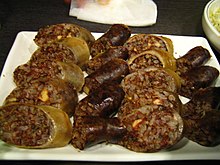



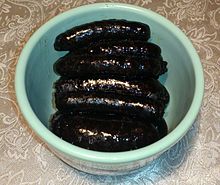
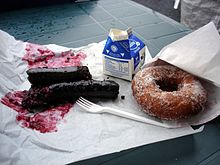
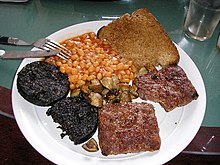
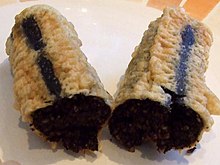

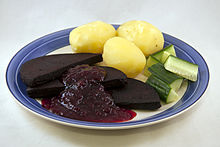






Blood Sausage (band)grainsmeat productsonionsspicesEnergyCarbohydratesSugarsProteinMineralsSodiumthe National AcademiessausageEuropethe AmericascornmealchestnutsbarleyoatmealbuckwheatIberian PeninsulaLatin Americaorange peelblack puddingmorongaMexicoFriulired onionscorianderkachumbaripaprikaterritoryPuerto RicoculantrocilantrocubanelleannattosupermarketsBrusselsSturgeon BayWisconsinBelgian AmericanFrench CanadianMichigankaszankaSan Francisco Bay Areabiroldopine nutsraisinssnoutsFresnoSanta RosaTorrance, CaliforniaSouth Bay areaboudingreen onionsYucatán PeninsulahabaneroAntiguaBarbadosFrench AntillesTrinidad and TobagoPanamaEl SalvadorNicaraguaHondurasGuatemalaCosta RicaEcuadorBoliviaColombiaFritangaVenezuelaRío de la Plataasado criollomixed grillbarbecueUruguayArgentinaParaguayguaranizationBrazilChiloteGuyanaintestineWhite puddingSurinamesliced sausagepig blood curdSundaedangmyeonsesame leavesfermenteddoenjang김치bean sproutsSwedenChinese cuisineshot potmainland Chinablood tofuChinesepinyinKaifengTibetan cuisinegyurmaMongoliakhorkhogagricultureaverse to bloodTochigi PrefectureShimotsuke Provincesoy sauceMatagiMutsu ProvincesJurchensTaiwanZhuyin Fuhaosticky riceSumatraPenangPenang HokkienCurry MeeLongganisaDinuguanlonganiza

